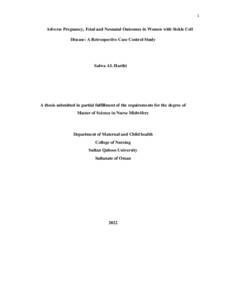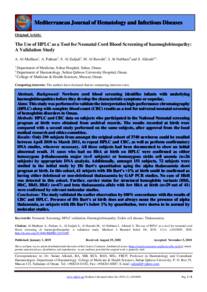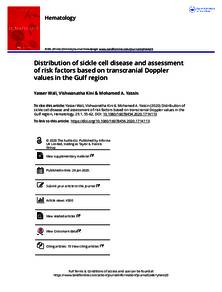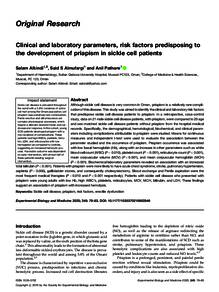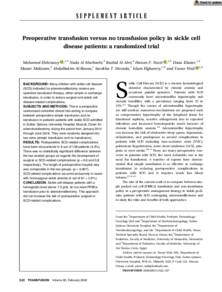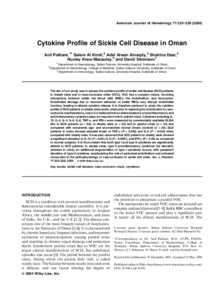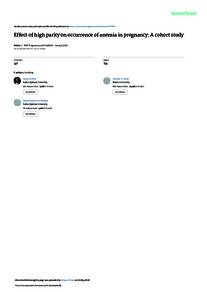Document
Adverse pregnancy, fetal and neonatal outcomes in women with sickle cell disease : a retrospective case control study.
Publisher
Sultan Qaboos University.
Gregorian
2022
Language
English
English abstract
Background
Pregnancies with Sickle cell anemia (SCA) and Sickle cell disease (SCD) are associated with high
maternal and fetal mortality. Moreover, it is associated with adverse pregnancy, fetal and neonatal
complications including Pre-eclampsia/eclampsia, Pregnancy Induced Hypertension (PIH),
anemia, preterm labor, vaso-occlusive crisis, fetal hypoxia, low birth weight (LBW), prematurity,
intrauterine growth retardation (IUGR), low APGAR and Neonatal Intensive Care Unit (NICU)
admission. Although, advancements have been noted in the management of these pregnancies,
pregnancy with SCD is still accompanied with increased maternal and neonatal outcomes despite
these advances.
Objective
The study aimed to explore the adverse pregnancy, fetal and neonatal outcomes among women
with sickle cell disease compared to non-SCD women.
Methods
A retrospective matched case-control study compared 171 pregnancies with sickle cell disease to
171 non-sickle cell disease pregnancies in Muscat. The data was retrieved from electronic medical
records and delivery registry book between Jan 2015 to August 2021. Deliveries <24 weeks or >
41weeks of gestation were excluded. Outcomes of interest included preterm labor, pre-eclampsia/
eclampsia, pregnancy induced hypertension, severe anemia, intrauterine growth retardation, fetal
distress, neonatal intensive care unit admission of neonates, low birth weight, and Low APGAR
score.
Results
Sickle cell disease women with severe anemia have increased odds of (x2=58.56, p<0.001) getting
adverse pregnancy outcomes than women without anemia. Sickle cell disease mothers had 21.97
% higher odds of getting an intrauterine growth retardation baby than non-sickle cell disease
mothers (x2=17.80, UOR= 2.91-166.13, p<0.001). Newborns born to Sickle cell disease mothers
had 3.93 % greater odds of being admitted to Neonatal intensive care unit than newborns born to
non-sickle cell disease mothers (x2=16.80, UOR= 1.97-7.84, p<0.001). Additionally, the children
born to sickle cell disease mothers had 10.90 % higher odds of being born with low birth weight
than children born to non-sickle cell disease mothers (x2=56.92, UOR= 5.36-22.16, p<0.001).
Hemoglobin level (OR= 0.17, p<0.001, 95% CI 0.10-3.0), past medical history (OR=7.95, 7 p<0.001, 95% CI 2.39-26.43), past surgical history (OR=17.69, p<0.001, 95% CI 3.41-91.76), and
preterm delivery (OR=9.48, p=0.005, 95% CI 1.95-46.23) were identified as predictors of adverse
pregnancy, fetal and neonatal outcomes.
Conclusion
Pregnant women with sickle cell disease are at increased risk for pregnancy, fetal, newborn adverse
outcomes compared to non- sickle cell disease mothers. Low rates of fetal mortality rate may
reflect improved antenatal surveillance and management in Oman.
Member of
Resource URL
Arabic abstract
الخلفية: ترتبط حالات الحمل بفقر الدم المنجلي ومرض فقر الدم المنجلي بارتفاع معدل وفيات الامهات والاجنة. علاوة على ذلك ، فإنه يرتبط بالحمل السلبي ، ومضاعفات الجنين وحديثي الولادة بما في ذلك تسمم الحمل / تسمم الحمل ، وارتفاع ضغط الدم الناجم عن الحمل ، وفقر الدم ، والمخاض المبكر ، وأزمة انسداد الاوعية الدموية ، ونقص الاكسجة الجنينية ، وانخفاض الوزن عند الولادة ، والخداج ، وتأخر النمو داخل الرحم ، وانخفاض درجة الابغار ودخول وحدة العناية المركزة لحديثي الولادة. وعلى الرغم من التقدم الذي لوحظ في إدارة حالات الحمل هذه، فإن الحمل بمرض فقر الدم المنجلي ال يزال مصحوبا بزيادة نتائج الامهات والاطفال حديثي الولادة على الرغم من هذه التطورات. الهدف: هدفت الدراسة إلى استكشاف نتائج الحمل والجنين وحديثي الولادة الضارة بين النساء المصابات بمرض فقر الدم المنجلي مقارنة بالنساء غير المصابات بمرض فقر الدم المنجلي الطريقة: قارنت الدراسة بأثر رجعي للحالات الضابطة 171 حالة حمل مصابة بمرض فقر الدم المنجلي ب 171 حالة حمل غير مصابة بمرض فقر الدم المنجلي في مسقط. تم استرداد البيانات من السجالت الطبية الالكترونية ودفتر سجل التسليم بين يناير 2015 وأغسطس .2021 تم استبعاد الوالدات أقل عن 24 أسبوعا أو أكبر عن 41 أسبوعا من الحمل. وشملت نتائج الاهتمام المخاض المبكر، وتسمم الحمل ، وارتفاع ضغط الدم الناجم عن الحمل، وفقر الدم الحاد، وتأخر النمو داخل الرحم، وضائقة الجنين، وقبول الاطفال حديثي الولادة في وحدة العناية المركزة لحديثي الولادة، وانخفاض الوزن عند الولادة، وانخفاض درجة الابغار. النتيجة: زادت النساء المصابات بفقر الدم المنجلي المصابات بفقر الدم الحاد من احتمالات الحصول على نتائج الحمل السلبية مقارنة بالنساء المصابات بمرض فقر الدم المنجلي. كان لدى أمهات مرض فقر الدم المنجلي احتمالات أعلى بنسبة ٪21.97 للحصول على طفل متخلف عن النمو داخل الرحم مقارنة بأمهات مرض فقر الدم المنجلي. كان لدى الاطفال حديثي الولادة المولودين ألمهات مصابات بمرض فقر الدم المنجلي احتمالات أكبر بنسبة ٪3.93 للدخول إلى وحدة العناية المركزة لحديثي الولادة مقارنة بالاطفال حديثي الولادة المولودين ألمهات غير مصابات بمرض فقر الدم المنجلي. بالاضافة إلى ذلك ، كان لدى الاطفال المولودين ألمهات مرض فقر الدم المنجلي احتمالات أعلى بنسبة ٪10.90 للوالدة بوزن منخفض عند الولادة مقارنة بالاطفال المولودين ألمهات غير مصابات بمرض فقر الدم المنجلي. تم تحديد مستوى الهيموغلوبين 9 ، والتاريخ الطبي السابق ، والتاريخ الجراحي السابق ، والولادة المبكرة كتنبؤات بالحمل السلبي ، ونتائج الجنين وحديثي الولادة. النتائج: النساء الحوامل المصابات بمرض فقر الدم المنجلي معرضات بشكل متزايد لخطر الحمل والجنين وحديثي الولادة مقارنة بالامهات السليمات وقد يعكس انخفاض معدالت وفيات الجنين تحسنا في المراقبة والادارة قبل الولادة في عمان.
Category
Theses and Dissertations

